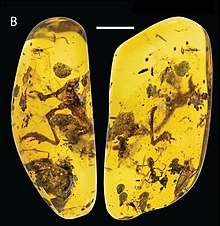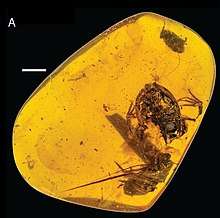Electrorana
Electrorana limoae is an extinct species of frog that lived in what is now Myanmar in the Cenomanian (Upper Cretaceous) forests, 99 million years ago.[1]

| Electrorana | |
|---|---|
 | |
| Holotype in Burmese amber | |
| Scientific classification | |
| Kingdom: | Animalia |
| Phylum: | Chordata |
| Class: | Amphibia |
| Order: | Anura |
| Genus: | †Electrorana Xing et al., 2018 |
| Species: | †E. limoae |
| Binomial name | |
| †Electrorana limoae Xing et al., 2018 | |
History of the discovery
A very well-preserved specimen of Electrorana was found in Myanmar inside a fragment of Burmese amber dating back to the Cretaceous period. This is an important finding because the amphibians were found in particular in the tropical forests, whose humid environment prevented fossilization. Together with the frog, a beetle was also found, possibly prey of the amphibian.[1]
Description
Although the specimen is not complete (part of the spine and a hind leg are missing)[2] and shows a slight initial decomposition, it is very useful to science because the skeletal structure is visible even to the naked eye.[3] It is a small frog, being about 2cm long.[1]
Links with current species
It has been hypothesized that Electrorana may show genetic links with living species, in particular with Alytes obstetricans.
References
- Xing, L.; Stanley, E. L.; Bai, M.; Blackburn, D. C. (2018). "The earliest direct evidence of frogs in wet tropical forests from Cretaceous Burmese amber". Scientific Reports. 8: Article number: 8770. doi:10.1038/s41598-018-26848-w. PMC 6002357. PMID 29904068.
- "Nell'ambra la più antica rana della foresta pluviale - Scienza & Tecnica". Ansa.it. 14 June 2018. Retrieved 14 July 2018.
- "World's Oldest Rain Forest Frogs Found in Amber". News.nationalgeographic.com. 14 June 2018. Retrieved 14 July 2018.